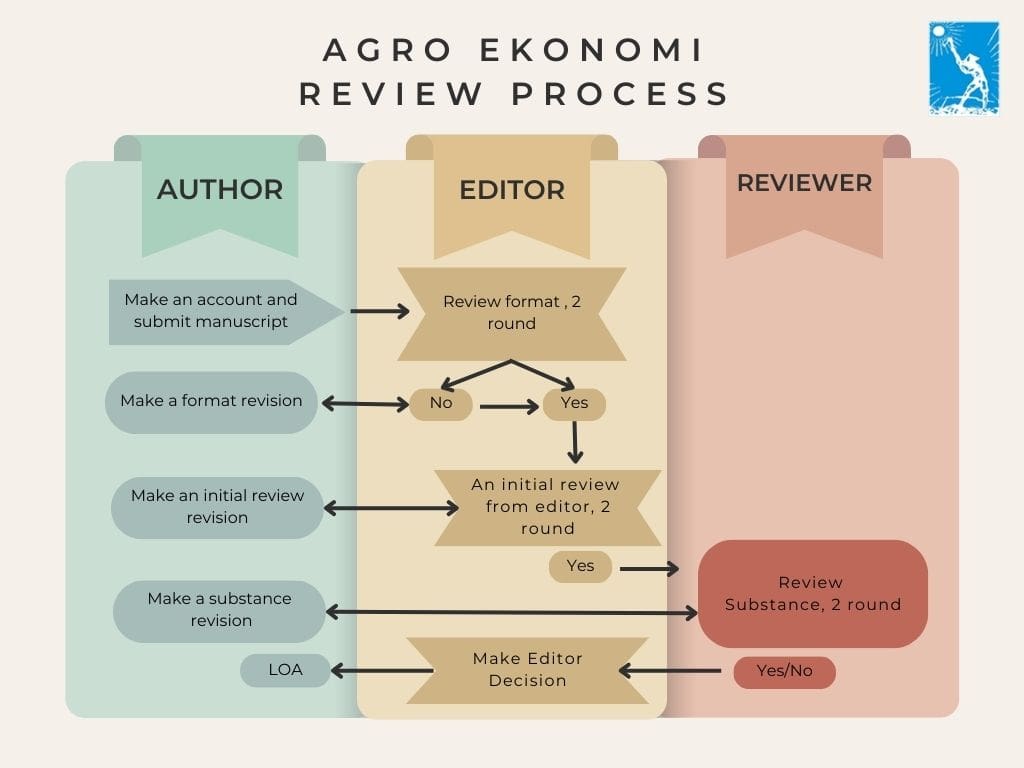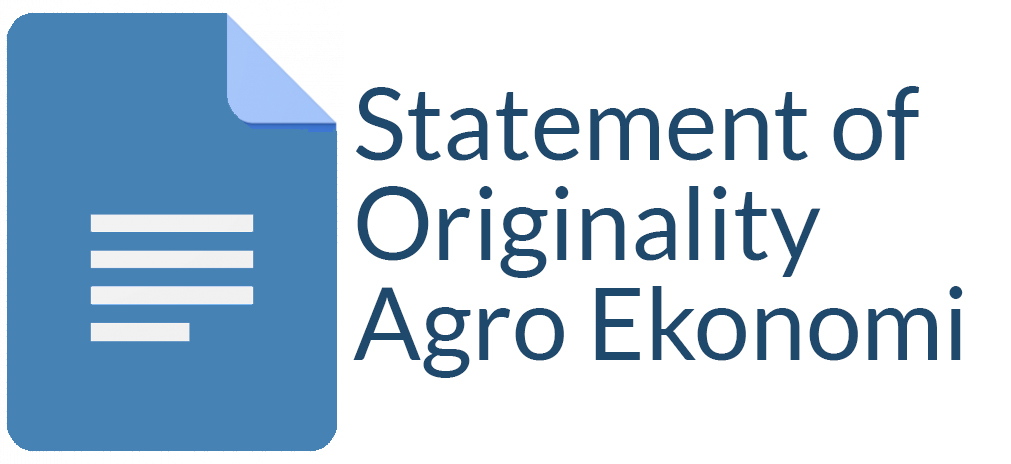Sustainability Of Community Food Barns: A Case Study Of Traditional Groups In Yogyakarta
Gilang Wirakusuma(1*), Sugiyarto Sugiyarto(2)
(1) Department of Agricultural Socio-economics, Universitas Gadjah Mada,Yogyakarta, Indonesia
(2) Department of Agricultural Socio-economics, Universitas Gadjah Mada,Yogyakarta, Indonesia
(*) Corresponding Author
Abstract
Community food barns (lumbung) are one of the local institutions established to maintain food security in rural areas. In line with this objective, several studies have been conducted to address concerns about the declining sustainability of traditional community food barns, which are vital for ensuring food security and preserving cultural heritage in rural areas. This indicates that there is an urgent need to strengthen local food systems and support rural development initiatives by assessing institutional factors influencing their sustainability. Therefore, this study aims to evaluate the sustainability of community food barns and identify the dominant factors. Multidimensional Scaling analysis was used to measure sustainability and determine the dominant influential factors. The study population comprised 32 respondents from 32 groups of barns spread across the Special Region of Yogyakarta. A total of 3 dimensions were involved in the analysis, namely institutional, socio-cultural, and economic. The analysis results showed that the sustainability of community food barns was classified as the 'quo' criterion. This indicated that the current status of the sustainability of traditional barns could not develop naturally to a higher level without intervention. In addition, the dominant factors determining the level of sustainability were identified from the 3 dimensions. Strategies to improve sustainability could be pursued from various aspects. Based on the results, the current study showed that fostering farmer group activities and enhancing collaboration with various stakeholders were essential for sustaining traditional community food barns. These efforts strengthened institutional support, promoted knowledge sharing, and ensured collective resource management, ultimately contributing to rural development and agricultural resilience.
Keywords
Full Text:
PDFReferences
REFERENCES
Altwegg, R., Roulin, A., Kestenholz, M., & Jenni, L. (2006). Demographic effects of extreme winter weather in the barn owl. Oecologia, 149(1), 44-51. https://doi.org/10.1007/s00442-006-0430-3
Bahua, M. (2018). Mohamad Ikbal Bahua : Jurnal Internasional : Farmers Community Empowerment through Institutional Strengthening of Rural Food Barn. , 10.
Baryshnikova, N., Altukhov, P., Naidenova, N., & Shkryabina, A. (2022). Ensuring global food security: transforming approaches in the context of agriculture 5.0. Iop Conference Series Earth and Environmental Science, 988(3), 032024. https://doi.org/10.1088/1755-1315/988/3/032024
Beus, C. E., & Dunlap, R. E. (1990). Conventional versus alternative agriculture: The paradigmatic roots of the debate. Rural Sociology, 55, 590–616.
Bozsik, N., Cubillos, J. P. T., Stalbek, B., Vasa, L., & Magda, R. (2022). Food security management in developing countries: Influence of economic factors on their food availability and access. PLoS ONE, 17(7 July), 1–24. https://doi.org/10.1371/journal.pone.0271696
Cobb, D., Dolman, P., & O’Riordan, T. (1999). Interpretations of sustainable agriculture in the UK. Progress in Human Geography, 23(2), 209–235.
Daskon, C. (2016). Significance of cultural values in securing asset portfolios of rural communities. Sri Lanka Journal of Social Sciences, 38(1), 31. https://doi.org/10.4038/sljss.v38i1.7384
Frison, E., Cherfas, J., & Hodgkin, T. (2011). Agricultural biodiversity is essential for a sustainable improvement in food and nutrition security. Sustainability, 3(1), 238-253. https://doi.org/10.3390/su3010238
Gitz, V., Meybeck, A., Lipper, L., Young, C., & Braatz, S. (2016). Climate change and food security: Risks and responses. In Food and Agriculture Organization of the United Nations. https://doi.org/10.1080/14767058.2017.1347921
Gunawan, C. and Pudjiastuti, A. (2022). Analysis of human resource management in the administration of food barns during the covid-19 pandemic in east java, indonesia. European Journal of Management Issues, 30(2), 75-82. https://doi.org/10.15421/192207
Guyomard, & Bureau. (2020). Research for AGRI Committee – The Green Deal and the CAP: policy implications to adapt farming practices and to preserve the EU’s natural resources. April, 1–162.
IPCC. (2014). In Core Writing Team, R. K. Pachauri & L. A. Meyer (Eds.), Climate change 2014: Synthesis report. Contribution of working Groups I, II and III to the Fifth Assessment Report of the Intergovernmental Panel on Climate Change ( 151 pp). Geneva, Switzerland: IPCC.
Irawan, N. and Nara, V. (2020). Managing women empowerment through participation in sustainable tourism development in kampong phluk, siem reap, cambodia. International Journal of Economics Business and Accounting Research (Ijebar), 4(02). https://doi.org/10.29040/ijebar.v4i02.1053
Irungu, R., Liu, Z., Liu, X., & Wanjiru, A. (2023). Role of Networks of Rural Innovation in Advancing the Sustainable Development Goals: A Quadruple Helix Case Study. Sustainability. https://doi.org/10.3390/su151713221.
Lartey, A. (2015). End hunger, achieve food security and improved nutrition and promote sustainable agriculture. UN Chronicle, 51(4), 6–8. https://doi.org/10.18356/5940d90a-en
Liu, J., Hull, V., Batistella, M., DeFries, R., Dietz, T., Feng, F., … & Zhu, C. (2013). Framing sustainability in a telecoupled world. Ecology and Society, 18(2). https://doi.org/10.5751/es-05873-180226
Macrae, G., & Reuter, T. (2020). Lumbung Nation. Indonesia and the Malay World, 48, 338 - 358. https://doi.org/10.1080/13639811.2020.1830535.
Marston, L. and Konar, M. (2017). Drought impacts to water footprints and virtual water transfers of the central valley of california. Water Resources Research, 53(7), 5756-5773. https://doi.org/10.1002/2016wr020251
McCarthy, J., & Obidzinski, K. (2017). Framing the food poverty question: Policy choices and livelihood consequences in Indonesia. Journal of Rural Studies, 54, 344-354. https://doi.org/10.1016/J.JRURSTUD.2017.06.004.
Nurfaizah, D., Pravitasari, A., Lubis, I., & Saizen, I. (2023). Land cover changes and spatial planning alignment in east java province. IOP Conference Series: Earth and Environmental Science, 1133(1), 012049. https://doi.org/10.1088/1755-1315/1133/1/012049
Ordonez‐Ponce, E., Clarke, A., & MacDonald, A. (2021). Business contributions to the sustainable development goals through community sustainability partnerships. Sustainability Accounting, Management and Policy Journal. https://doi.org/10.1108/sampj-03-2020-0068.
Pawlak, K., & Kołodziejczak, M. (2020). The role of agriculture in ensuring food security in developing countries: Considerations in the context of the problem of sustainable food production. Sustainability (Switzerland), 12(13). https://doi.org/10.3390/su12135488
Purnomo, S., Darwin, M., Abdullah, I., & Susilastuti, D. H. (2023). Collaboration strategy for building village communities through economic empowerment in bumdes business units. Interdisciplinary Social Studies, 2(4), 1854-1865. https://doi.org/10.55324/iss.v2i4.402
Reardon, T. (1998). Rural non-farm income in developing countries. 282–356. https://doi.org/10.18356/3a70d1b6-en
Riptanti, E., Qonita, A., & , S. (2018). Revitalization of food barns in supporting sustainable food security in Central Java. IOP Conference Series: Earth and Environmental Science, 122. https://doi.org/10.1088/1755-1315/122/1/012002.
Rosmiati, A. A. M., Noor, T. I., & Hakim, D. L. (2020). ( Studi Kasus pada Kelompok Lumbung Pangan “ Indra Bakti IV ” di Desa Jatinagara Kecamatan Jatinagara Kabupaten Ciamis ) PENDAHULUAN Kelompok Indra Bakti IV terletak di Desa Jatinagara dengan jumlah anggota sebanyak 61 orang yang merupakan salah satu Kelo. Agroinfo Galuh, 7(2), 498–509.
Sawitri Dj, A. A. A. W., & Sudarma, I. M. (2018). The Role Of Foodstuffs In Keeping Food Security In Tabanan District. Jurnal Manajemen Agribisnis, 6(2), 20–23.
Tripathi, A. D., Mishra, R., Maurya, K. K., Singh, R. B., & Wilson, D. W. (2019). Estimates for World Population and Global Food Availability for Global Health. The Role of Functional Food Security in Global Health, 3–24. doi:10.1016/b978-0-12-813148-0.00001-3
Velten, S., Leventon, J., Jager, N. W., & Newig, J. (2015). What is sustainable agriculture? A systematic review. Sustainability, 7(6), 7833–7865.
Warner, K. D. (2007). The quality of sustainability: Agroecological partnerships and the geographic branding of California winegrapes. Journal of Rural Studies, 23(2), 142–155.
Wulansari, P. D., Rasidin, M., & Witro, D. (2021). Revitalization of food barns to support community and national food security. Jurnal Ekonomi Dan Kebijakan Publik, 12(1), 45-56. https://doi.org/10.22212/jekp.v12i1.1628
Zarate Malpica, A. H., & Miranda Zambrano, G. A. (2016). The impact of climate change on food security in vulnerable rural zones in the Peruvian Andes. Revista Mexicana de Ciencias Agricolas, 7(1), 71–82. http://cienciasagricolas.inifap.gob.mx/editorial/index.php/Agricolas/article/vie
Article Metrics
Refbacks
- There are currently no refbacks.
Copyright (c) 2023 Agro Ekonomi

This work is licensed under a Creative Commons Attribution-ShareAlike 4.0 International License.
View My Stats











